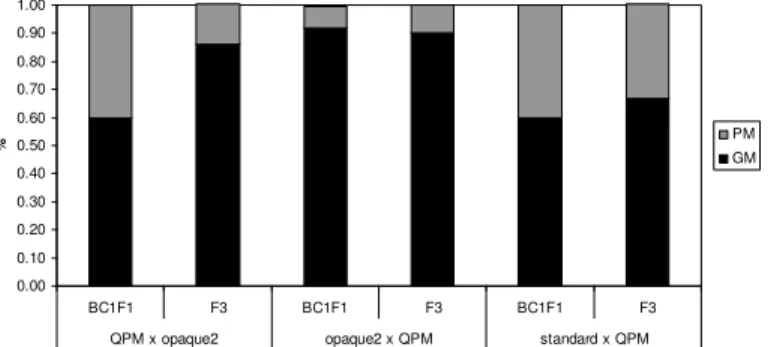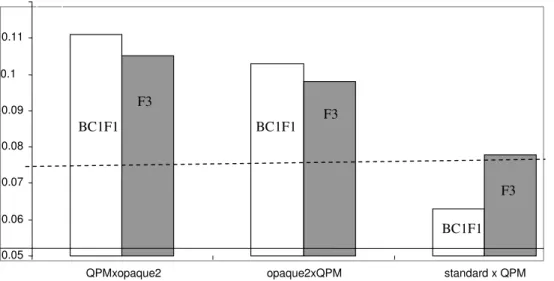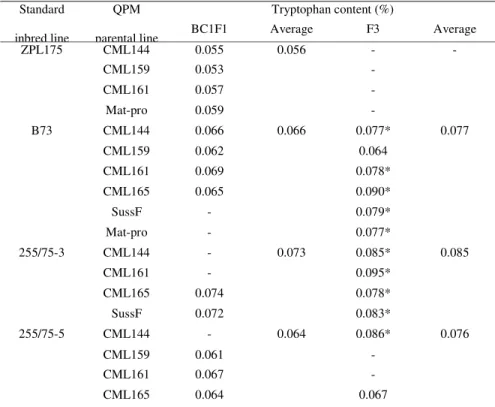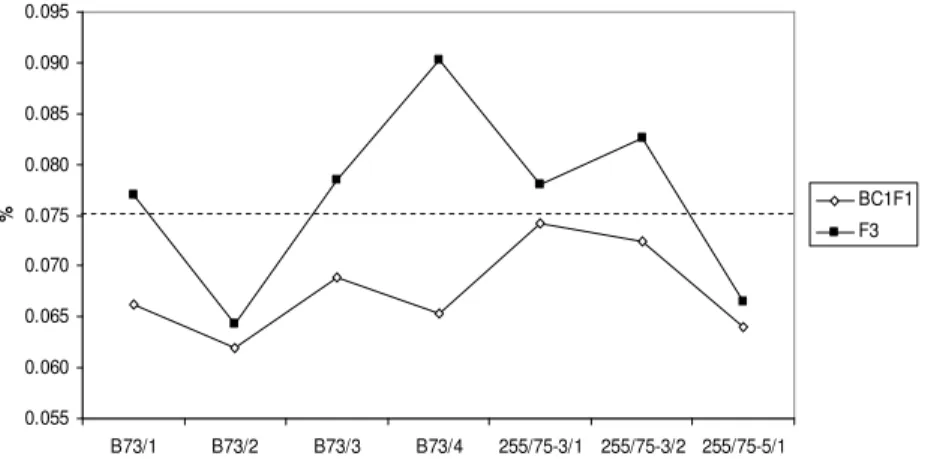____________________________
Corresponding author: Dragana Ignjatovi -Mici ,,Maize Research Institute „Zemun Polje“, S. Baji a 1, 11185 Belgrade,Serbia,,Tel: 011/3756704,
Fax: 011/3756707,e-mail: idragana@mrizp.rs
UDC 575:633.15 DOI: 10.2298/GENSR1002267M
Original scientific paper
KERNEL MODIFICATIONS AND TRYPTOPHAN CONTENT IN QPM SEGREGATING GENERATIONS
Dragana IGNJATOVI -MICI , Goran STANKOVI , Ksenija MARKOVI , Snežana MLADENOVI DRINI , Vesna LAZI -JAN I , and Miloje DENI
Maize Research Institute „Zemun Polje“, Belgrade, Serbia
Mici Ignjatovi D., G. Stankovi , K. Markovi , S. Mladenovi Drini , V. Lazi Jan i and M. Deni (2010):Kernel modifications and tryptophan content in QPM segregating generations.- Genetika, Vol 42, No. 2, 267 -278.
The main selection steps in QPM breeding involve assessing kernel modifications and tryptophan level in each generation. Herein, we present the results of the analysis for these traits on F3 and BC1F1 generations of QPM x opaque2, opaque2 x QPM and standard lines x QPM crosses. The results showed that the majority the genotypes had kernel types 2 and 3 (good modifications). The whole grain tryptophan content in F3 and BC1F1 genotypes of crosses between QPM and opaque2 germplasm was at the quality protein level, with a few exceptions. All BC1F1 genotypes of standard lines x QPM had tryptophan content in the range of normal maize, while majority of F3 genotypes had tryptophan content at level of QPM. The progeny (with increased tryptophan levels) of QPM and opaque2 crosses had significantly higher tryptophan content compared to the progeny of crosses between standard and QPM lines – 0.098 to 0.114 and 0.080, respectively. All genotypes that had poorly modified kernels and/or low tryptophan content will be discarded from further breeding.
Key words: kernel modifications, maize, opaque2, QPM, tryptophan content
INTRODUCTION
Maize is one of the most important crops in human and animal nutrition. However, like most other cereals, its nutritional value is poor due to deficiency of two essential amino acids – tryptophan and lysine. It was shown that opaque2 (o2) mutation can nearly double the lysine content of the endosperm compared with the wild type (MERTZ et al., 1964; EGGUM et al., 1983; EGGUM et al., 1985). Maize homozygous for the o2 (recessive) mutation has substantially higher lysine and tryptophan content than maize that is either homozygous dominant (O2O2) or heterozygous (O2o2) for the opaque2 locus (CROW and KERMICLE, 2002). BRESSANI (1992) showed that increased concentrations of these two amino acids in the grain endosperm can double the biological value of maize protein. The biological value of QPM protein is about 80% that of milk is about 90% and that of normal maize 45% (FAO 1992).
Incorporation of opaque2 into high yielding cultivars was not commercially successful, because of its numerous agronomic and processing problems – reduced grain yield, soft endosperm, chalky and dull kernel appearance and susceptibility to ear rots and stored grain pests.These drawbacks have been corrected in genetically improved, hard endosperm quality protein maize – QPM (VIVEKet al., 2008). QPM is a genotype in which opaque2 has been incorporated along with associated modifiers - the endosperm hardness modifier genes that convert the soft/opaque mutant endosperm to a hard/vitreous endosperm and modifier/enhancers that confer higher tryptophan and lysine content. Thus, breeding of QPM varieties requires manipulation of three different genetic systems (KRIVANEKet al., 2007).
obvious from the fact that in 1977 only four countries grew QPM, but in 2003 more than 23 countries have realised QPM varieties for large scale cultivation on area over 3.5 million hectares (SOFIet al., 2009). Although QPM development was primarily targeted at developing and under-developed countries, its production and consumption in developed countries could also be advantageous. Application of QPM as animal feed can be very beneficial (increased weight gain) especially for monogastric animals such as pigs and poultry, which require a more complete protein than cereals alone can provide. In Brazil and El-Salvador use of QPM in animal feed reduced use of soybean meal by about 50% besides reducing use of synthetic lysine supplements (LOPEZ-PEREIRA, 1992).
QPM germplasm is of tropical and sub-tropical origin and its adaptation to temperate climatic region is a challenging task. Maize Research Institute (MRI) maintains a collection of opaque2 inbred lines developed in the seventies (DENI et al., 1979; DENI et al., 1984; DRINI et al., 2007; KONSTANTINOV and MLADENOVIC DRINIC, 2007). Recently, these lines have been analyzed for protein and tryptophan content and are used for breeding QPM (IGNJATOVI -MICI et al., 2008; IGNJATOVI -MICI et al., 2009). Besides good agronomic performances, there are two unique and essential steps in the development of QPM germplasm (VIVEKet al., 2008). The first is to simultaneously identify segregants in a family or population having the o2 allele in the homozygous recessive (o2o2) condition with a hard endosperm, through kernel modification score. The second step is to identify and confirm the presence of the essential amino acids, i.e. percentage of tryptophan in a sample. The breeding project at MRI involves QPM x opaque2, opaque2 x QPM and standard lines x QPM crosses, with the aim to improve MRI opaque2 or convert standard lines to QPM germplasm. Following the selection steps, choice of the material for further selection was based on kernel modification score and tryptophan level in each generation. Herein, we present the results of the analysis of F3 and BC1F1 generations for kernel modification and tryptophan content for all three types of crosses.
MATERIALS AND METHODS
The material analyzed for kernel modifications and tryptophan content consisted of F3 and BC1F1 progeny of three different types of crosses - QPM x opaque2, opaque2 x QPM and standard lines x QPM. Four QPM lines (CML144, CML159, CML161 and CML165 from CYMMIT, Mexico), two QPM varieties (SussF and Mat-pro from IIAM, Mozmbique) and 15 opaque2 lines (from MRI, Serbia) were used for producing QPM x opaque2 genotypes (28 F3 and 19 BC1F1) and opaque2 x QPM genotypes (20 F3 and 15 BC1F1). F3 (9 genotypes) and BC1F1 (19 genotypes) generations of standard lines x QPM were obtained by crossing four standard inbred lines (ZPL175, B73, 255/75-3 and 255/75-5) with CML144, CML159, CML161, CML165, SussF and Mat-pro.
opaque, while scores 3 and 4 are given to 50% and 75% opaque kernels, respectively.
Tryptophan content was determined according to NURIT et al. (2009). The protocol is based on the Hopkins-Cole reaction, in which one molecule glyoxylic acid and two molecules tryptophan form a colored compound with a maximum absorption at 560nm. Briefly, random samples of 30 seeds were grounded to a fine powder, defatted and digested with papain. Colorimetric reaction was developed using FeCl3-6H2O dissolved in glacial acetic acid and 30N H2SO4. Absorption was
read at 560nm in a spectrophotometer. Tryptophan % was calculated using a standard (calibration) curve, developed with known amounts of tryptophan, ranging from 0 to 30µg/ml.
RESULTS AND DISCUSSION
Kernel modifications
Kernel modification scores for F3 and BC1F1 generations of all three cross types are presented on Graphic 1. Both type 2 and type 3 kernels (good modifications) can be used for further selection, while type 4 and type 5 (poor modifications) are discarded. Genotypes were scored according to the majority of the kernel modification – if most of the seeds were scored 3, and a small fraction was scored 4 or 2, than the whole genotype was scored 3.
The best modifications were recorded among opaque2 x QPM BC1F1 and F3 genotypes, i.e. 8% and 10% genotypes had poor modifications (mostly type 4 kernels). The highest number of genotypes with poorly modified kernels was found in BC1F1 of QPM x opaque2 crosses, i.e. 40%, while in the F3 genotypes of the same type of crosses 85% of the genotypes had good and only 14% poor modification scores. In F3 genotypes of standard line x QPM crosses 67% of genotypes had type 3 and type 2 kernels and in BC1F1 60% of genotypes had kernels with good endosperm modifications.
0.00 0.10 0.20 0.30 0.40 0.50 0.60 0.70 0.80 0.90 1.00
BC1F1 F3 BC1F1 F3 BC1F1 F3
QPM x opaque2 opaque2 x QPM standard x QPM
% PM
GM
Graphic 1 . Kernel modifications in different types of crosses and generations
Tryptophan content
Crosses between QPM and opaque2 germplasm
The average tryptophan content (%) in whole grain (ATC) of different types of crosses and generations are presented on Graphic 2. In both QPM x opaque2 and opaque2 x QPM germplasm ATC was significantly higher than the limit of 0.075 set for QPM germplasm. There were no significant differences between BC1F1 and F3 generations – values were 0.111 and 0.105 for QPM x opaque2 and 0.103 and 0.098 for opaque2 x QPM, respectively. Overall, ATC was slightly higher in QPM x opaque2 compared to opaque2 x QPM – 0.111 vs. 0.103 in BC1F1 and 0.105 vs. 0.098 in F3, respectively. Also, in both types of crosses ATC was slightly higher in BC1F1 vs. F3. All these differences can be considered negligible as they are in the range from 0.005 (between BC1F1 and F3 generations of QPM x opaque2) to 0.008 (between BC1F1 generations). Among all analyzed genotypes, only CML144 x P802 in F3 had tryptophan content below the 0.75 limit, i.e. 0.064. Within both cross types and generations in all the other genotypes tryptophan content ranged from 0.078 to 0.146.
Graphic 2 .Whole grain average tryptophan contents (%) in different types of crosses and generations (dashed line – tryptophan threshold level for QPM)
Crosses between standard and QPM lines
Tryptophan content in F3 and BC1F1 generations of standard lines x QPM crosses showed significant differences. ATC for all crosses in BC1F1 genotypes was below the QPM limit - 0.064 and in F3 genotypes over the QPM limit – 0.078. The lowest ATC was determined in BC1F1 progeny of ZPL175 and the highest in F3 progeny of 255/75-3 (Graphic 3).
0.05 0.06 0.07 0.08 0.09 0.1 0.11
QPMxopaque2 opaque2xQPM standard x QPM
BC1F1 F3
BC1F1 F3
Graphic 3. Whole grain average tryptophan content (%) in BC1F1 and F3 progeny of different crosses between standard and QPM lines (dashed line – tryptophan threshold level for QPM)
Table 1 Tryptophan content (%) in whole grains of BC1F1 and F3 genotypes of crosses between standard and QPM germplasm
Tryptophan content (%) Standard
inbred line
QPM
parental line BC1F1 Average F3 Average
CML144 0.055 -
CML159 0.053 -
CML161 0.057 -
ZPL175
Mat-pro 0.059
0.056
-
-
CML144 0.066 0.077*
CML159 0.062 0.064
CML161 0.069 0.078*
CML165 0.065 0.090*
SussF - 0.079*
B73
Mat-pro -
0.066
0.077*
0.077
CML144 - 0.085*
CML161 - 0.095*
CML165 0.074 0.078*
255/75-3
SussF 0.072
0.073
0.083*
0.085
CML144 - 0.086*
CML159 0.061 -
CML161 0.067 -
255/75-5
CML165 0.064
0.064
0.067
0.076
The ears of maize F3 plants of all four crosses between standard line ZPL175 and CML144, CML159, CML161 and Mat-pro were barren, while ATC in BC1F1 genotypes of the same crosses was far below the QPM limit, i.e. 0.056 (from 0.053 to 0.059). Genotypes with 255/75-3 as a parental line showed the highest ATC in both F3 (0.085) and BC2 (0.073) compared with all the other crosses. The results of tryptophan content analysis for each genotype are given in Table 1.
Out of 18 crosses between standard and QPM lines, only seven survived in both BC1F1 and F3 generations, while the other 11 gave barren ears in one of the two generations (Table 1). It is obvious that tryptophan content is higher in F3 compared to BC1F1 genotypes of the same cross (Graphic 4). Only two genotypes derived from B73 x CML159 and 255/75-5 x CML165 had tryptophan content below the QPM limit in both generations. The highest difference between generations was detected in B73 x CML165 (0.025) and the lowest in 255/75-3 x CML165 (0.004).
0.055 0.060 0.065 0.070 0.075 0.080 0.085 0.090 0.095
B73/1 B73/2 B73/3 B73/4 255/75-3/1 255/75-3/2 255/75-5/1
% BC1F1
F3
Graphic 4. Whole grain tryptophan content (%) in BC1F1 and F3 progeny of individual crosses between standard and QPM germplasm (dashed line – tryptophan threshold level for QPM)Legend: B73/1 – B73 x CML144; B73/2 - B73 x CML159; B73/3 - B73 x CML161; B73/4 - B73 x CML165; 3/1 – 255/75-3 x CML165; 255/75-255/75-3/2 - 255/75-255/75-3 x SussF; 255/75-5/1 - 255/75-5 x CML165.
DISCUSSION
remaining advanced generations (VIVEK et al., 2008). Type 3 kernels are the best choice in early generations, as it is a compromise between the guaranteed presence of o2o2 (a higher priority) and good modification (which can be improved in subsequent generations). Type 1 kernels are most probably O2O2 or O2o2, type 5 kernels are the same as original o2o2 mutant and type 4 kernels have low probability of obtaining good modifications in subsequent generations. That is way these kernels are discarded throughout the selection process.
The modifications in the analyzed segregating generations of different crosses between QPM, opaque2 and standard maize germplasms were overall good. Most of the genotypes had kernel modifications in the score range from 2 to 3. Good kernel modifications were detected in over 60% of all genotypes in the three types of crosses. Even those genotypes that were scored as with poorly modified kernels had a small portion of well modified kernels which were used for further selection. Only three genotypes (two QPM x opaque2 and one standard line x QPM) were completely discarded because they did not produce enough type 2 and type 3 kernels. Most of thegenotypes with well modified kernels derived from well modified F2 and BC1 kernels (78% of all analyzed genotypes), but in 14% of the genotypes modifications were downgraded (data not presented). The mechanisms by which the endosperm modifiers change the grain structure from chalky to vitreous is not clearly understood, neither have the genes been characterized in terms of their number, chromosomal location, nor expression levels in different genetic background (PRASSANAet al., 2001; SOFI et al., 2009). Information available so far strongly suggest the occurrence of two major loci on chromosome 7 influencing endosperm modification from the opaque to vitreous phenotype (LOPES et al., 1995), with several minor factors possibly fine-tuning the process (PRASSANAet al., 2001).
Lysine and tryptophan concentrations in maize kernels of QPM are highly correlated (NURIT et al., 2009). A 3:1 ratio of lysine to tryptophan has been reported in normal and quality protein maize (BJARNSONet al., 1992; VIVEK et al, 2008). Therefore, in a QPM breeding program only tryptophan content is monitored, due to simpler and faster determination method. The whole grain tryptophan content in F3 and BC1F1 genotypes of crosses between QPM and opaque2 germplasm was at level of quality protein maize tryptophan content, with a few exceptions. All BC1F1 genotypes of standard lines x QPM had tryptophan content in the range of normal maize, while majority of F3 genotypes had tryptophan content at level of QPM. All the genotypes that had low tryptophan content will be discarded from further breeding.
The progeny (with increased tryptophan levels) of QPM and opaque2 crosses had significantly higher tryptophan content compared to the progeny of crosses between standard and QPM lines – 0.098 to 0.114 and 0.080, respectively. This was expected, as QPM and opaque2 parental lines have homozygous recessive o2o2opaque2 gene and thus increased tryptophan content, while standard lines are homozygous dominant O2O2 and thus poor in tryptophan.
tryptophan and quality index are set (VIVEKet al., 2008), some QPM lines are to a certain extent below them. OKELLO et al. (2006) tested six QPM lines and six normal inbred lines for endosperm tryptophan content, agronomic performances and disease resistance. In three QPM lines analyzed quality index was from 0.060 to 0.068 (limit > 0.07), although their tryptophan content was high. However, these quality index values were higher compared to majority of normal lines (five lines below 0.05 and one 0.066). Quality index was not performed on BC1F1 and F3 genotypes in our work due to time limit considering sowing and the fact that either F3 or F4 generation are recommended as the first generation to determine protein quality (VIVEKet al., 2008). Tryptophan content was determined with the aim to discard genotypes not only with inadequate kernel modifications but also with low tryptophan values.
Having in mind the number of different genes that are needed to produce a quality protein genotype (opaque2 and different modifier genes), it can be said that from a simple genetic system in o2 QPM has evolved by combination of various genetic systems, behaving to be handled like classical quantitative trait (SOFIet al., 2009).
CONCLUSION
In the majority of different F3 and BC1F1 genotypes of QPM, opaque2 and standard lines crosses kernel modifications and tryptophan content were in the categories which enable further breeding for quality protein maize. The only exception was BC1F1 of standard lines and QPM crosses, with no increased tryptophan content in any of the analyzed genotypes, but the results in F3 were promising for improving several standard lines for protein quality. However, it is necessary to determine agronomical characteristics that play an important role in developing desirable genotypes and this will be performed in the next breeding generation.
ACKNOWLEDGEMENT
This research was sponsored by Republic of Serbia Ministry of Science and Technological Development through the Project TR20039.
Received February 11th, 2010
Accepted June 22th, 2010
REFERENCES
AKUAMOA-BOATENG , A. (2002): Quality protein maize infant feeding trials in Ghana. Ghana Health Service. Ashanti, Ghana.
BJARNSON M., S.K. VASAL (1992): Breeding for quality protein maize. Plant Breed. R. 9: 181-216.
BRESSANI, R. (1991): Protein quality of high lysine maize for humans. Cereal Foods World 36: 806-811.
BRESSANI, R. (1992): Nutritional Value of high-lysine maize in humans. In E.T. Mertz (ed.). Quality Protein Maize. American Association of Cereal Chemists, St. Paul, MN.
DENI , M., V. HADŽI-TAŠKOVI ŠUKALOVI, D. JELENI , J. DUMANOVI , I. BOŽOVI (1979): Comparison of some chemical methods for screening maize genotypes with improved protein quality. Genetika Vol 11(1): 75-83.
DENIC, M., J. DUMANOVIC, D.MIŠEVIC, Ž.STOJANOVIC, K. KONSTANTINOV, D. FIDLER (1984): Use of wheat and maize protein mutants in breeding for improved protein quantity and quality. Cereal Grain Protein Improvement. International Atomic Energy Agency, Vienna.
DRINI , G., G.STANKOVI , Z.PAJI , J.VAN ETOVI ,D.IGNJATOVI -MICI (2007): Sixty years of ZP maize hybrids breeding. Maydica. 52: 281-288.
EGGUM, B.O., J. DUMANOVI , D. MIŠEVI and M. DENI (1983): Grain yield and nutritive value of high oil opaque and waxy maize hybrids. J. Cereal Sci. 1: 139-145.
EGGUM, B.O., J. DUMANOVI , D. MIŠEVI and M. DENI (1985): Nutritive quality and energy yield of high oil, opaque-2 and waxy maize hybrids compared to normal maize hybrids. Qual. Plant Foods Num. Nutr. 35: 165-174. IGNJATOVI -MICI D., G. STANKOVI , K. MARKOVI , V. LAZI -JAN I , M. DENI (2008): Quality Protein
Maize – QPM. Genetika, Vol. 40, No. 3, 205-214.
IGNJATOVI -MICI D., K. MARKOVI , D. RISTI , S. MLADENOVI DRINI , S. STANKOVI , V. LAZI -JAN I , M. DENI (2009): Variability analysis of normal and opaque2 maize inbred lines. Genetika,
Vol. 41, No. 1, 81 -93.
KONSTANTINOV, K. and S. MLADENOVIC DRINIC (2007): Molecular genetics - step by step implementation in maize breeding. Genetika, Vol. 39, No. 2, 139 -154.
KRIVANEK A., H. GROOTE, N. GUNARATNA, A. DIALLO, D. FREISEN (2007): Breeding and disseminating quality protein maize for Africa. Afr. J. Biotech. 6: 312-324.
LOPEZ-PEREIRA, M.A. (1992): The economics of quality protein maize fully acknowledged as an animal feed: case studies of Brazil and El Salvador. CIMMYT Economics Working Paper 92-06. CIMMYT, Mexico, D.F.
LOPES M. A.and B. A. LARKINS (1995) Genetic analysis of opaque2 modifier gene activity in maize endosperm. Theoretical and Applied Genetics 91: 274-281.
MERTZ ET., L.S. BATES, O.E. NELSON (1964): Mutant that changes protein composition and increases lysine content of maize endosperm. Science 145: 279-280.
MORALES –GUERRA M. (2002): Effecto del consumo de maiz de alta calidad proteinica en nino(a)s de familias indigenas de las regiones Mazateca y Mixe del Estado de Oaxaca. PhD Thesis, Colegio de Postgraduados, Montecillo, Texcoco, Edo. de Mexico.
NURIT E., A. TIESSEN, K. PIXLEY, N. PALACIOS-ROJAS (2009): Reliable and inexpensive colorimetric method for determining protein-bound tryptophan in maize kernels. J. Agric. Food Chem.
57:7233-7238.
OKELLO D.K., R. MANNA, J. IMANYWOHA, K. PIXLEY, R. EDEMA (2006): Agronomic performance and breeding potential of selected inbred lines for improvement of protein quality of adapted Ugandan maize germplasm. African Crop Science Journal14(1): 37-47.
PRASSANA B.M., S.K. VASAL, B. KASSAHUN, N.N. SINGH (2001): Quality protein maize. Current Science
81(10): 1308-1309.
SOFI P.A., S.A. WANI, A.G. RATHER, S.H. WANI (2009): Review article: Quality protein maize (QPM): genetic manipulation for the nutritional fortification of maize. J. Plant Breed. Crop Sci. 1(6):
VIVEK B.S., A.F. KRIVANEK, N. PALACIOS-ROJAS, S. TWUMASI-AFRIYIE, A.O. DIALLO (2008): Breeding Quality Protein Maize (QPM): Protocols for Developing QPM Cultivars. Mexico, D.F.: CIMMYT.
MODIFIKACIJA ZRNA I SADRŽAJ TRIPTOFANA U SEGREGIRAJU IM GENERACIJAMA KUKURUZA VISOKOG KVALITETA PROTEINA
Dragana IGNJATOVI -MICI , Ksenija MARKOVI , Snežana MLADENOVI DRINI , Vesna LAZI -JAN I , Miloje DENI
Institut za kukuruz „Zemun Polje“,Beograd, Srbija
I z v o d
Iako recesivna opaque2 (o2) mutacija zna ajno pove ava sadržaj lizina i triptofana u zrnu kukuruza, inkorporacija opaque2 u visoko prinosne genotipove nije uspela, zbog brojnih problema koji su se javili kao posledica mekog endosperma. Kukuruz visokog kvaliteta proteina (QPM) je opaque2 kukuruz sa poboljšanom tvrdo om zrna i dobrim agronomskim performansama, stvoren prvenstveno od tropske i subtropke germplazme. U Institutu za kukuruz je u toku projekat koji za cilj ima poboljšanje sopstvenih opaque2 linija i prevo enje standardnih linija u QPM kukuruz.. U ovom radu predstavljamo rezultate analiza modifikacije zrna i sadržaja triptofana u F3 i BC1F1 generacijama ukrštanja QPM x opaque2, opaque2 x QPM i standardne linije x QPM. Ve ina genotipova je imala zrno tipa 2 i tipa3 (dobre modifikacije). Sadržaj triptofana u celom zrnu genotipova ukrštanja QPM i opaque2 linija je bio na nivou karakteristi nom za QPM, sa nekoliko izuzetaka. Sadržaj triptofana u potomstvu ukrštanja standardne linije x QPM je bio pove an kod ve ine F3 genotipova. Potomstvo (sa pove anim sadržajem triptofana) ukrštanja QPM i opaque2 linijaje imalo znatno ve i sadržaj ove aminokiseline u odnosu na potostvo ukrštanja standardne linije x QPM - – od 0.098 do 0.114 prema 0.080. Genotipovi sa lošim modifikacija zrna i/ili niskim sadržajem triptofana e biti eleminisani iz daljeg procesa selekcije.



